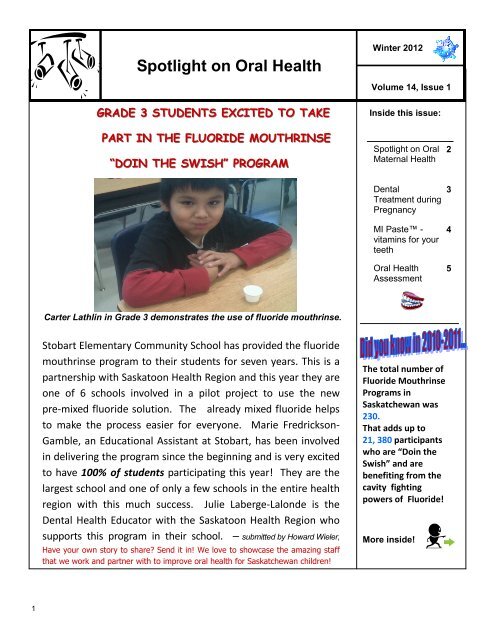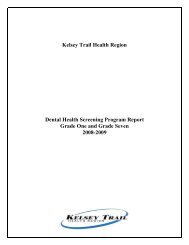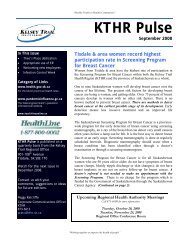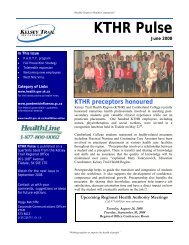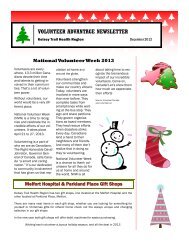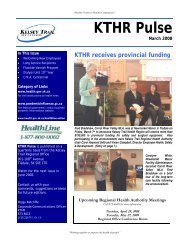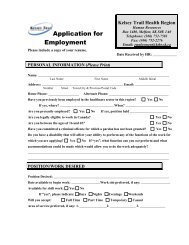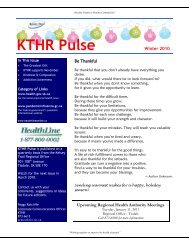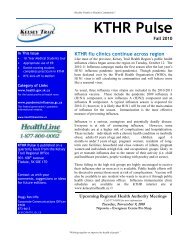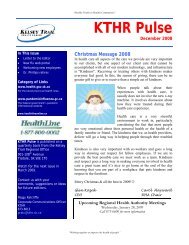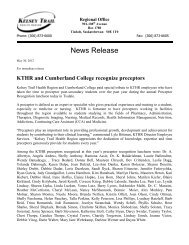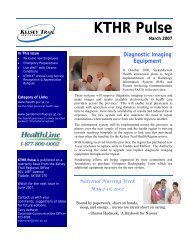Kelsey Trail Health Region
Kelsey Trail Health Region
Kelsey Trail Health Region
Create successful ePaper yourself
Turn your PDF publications into a flip-book with our unique Google optimized e-Paper software.
Spotlight on Oral <strong>Health</strong><br />
Winter 2012<br />
Volume 14, Issue 1<br />
GRADE 3 STUDENTS EXCITED TO TAKE<br />
PART IN THE T<br />
FLUORIDE MOUTHRINSE<br />
“DOIN THE SWISH” PROGRAM<br />
Inside this issue:<br />
Spotlight on Oral<br />
Maternal <strong>Health</strong><br />
2<br />
Dental<br />
Treatment during<br />
Pregnancy<br />
MI Paste -<br />
vitamins for your<br />
teeth<br />
Oral <strong>Health</strong><br />
Assessment<br />
3<br />
4<br />
5<br />
Carter Lathlin in Grade 3 demonstrates the use of fluoride mouthrinse.<br />
Stobart Elementary Community School has provided the fluoride<br />
mouthrinse program to their students for seven years. This is a<br />
partnership with Saskatoon <strong>Health</strong> <strong>Region</strong> and this year they are<br />
one of 6 schools involved in a pilot project to use the new<br />
pre-mixed fluoride solution. The already mixed fluoride helps<br />
to make the process easier for everyone. Marie Fredrickson-<br />
Gamble, an Educational Assistant at Stobart, has been involved<br />
in delivering the program since the beginning and is very excited<br />
to have 100% of students participating this year! They are the<br />
largest school and one of only a few schools in the entire health<br />
region with this much success. Julie Laberge-Lalonde is the<br />
Dental <strong>Health</strong> Educator with the Saskatoon <strong>Health</strong> <strong>Region</strong> who<br />
supports this program in their school. – submitted by Howard Wieler,<br />
Have your own story to share? Send it in! We love to showcase the amazing staff<br />
that we work and partner with to improve oral health for Saskatchewan children!<br />
The total number of<br />
Fluoride Mouthrinse<br />
Programs in<br />
Saskatchewan was<br />
230.<br />
That adds up to<br />
21, 380 participants<br />
who are “Doin the<br />
Swish” and are<br />
benefiting from the<br />
cavity fighting<br />
powers of Fluoride!<br />
More inside!<br />
1
Spotlight on Oral <strong>Health</strong><br />
Excerpts from the report on ‘Maternal Oral <strong>Health</strong> and Pregnancy Outcomes’<br />
Myth: A pregnant woman loses a tooth for every child she has.<br />
Fact: Loosing a tooth during pregnancy is an old wives tale. Tooth loss during pregnancy<br />
could be due to poor oral health or due to hormonal changes in the oral cavity that<br />
predispose women to lose teeth. (Al Habashneh, Guthmiller, Levy, Johnson, Squier, Dawson, & Fang,<br />
2005).<br />
Myth: A woman loses calcium from her teeth during pregnancy and develops cavities as a<br />
result.<br />
Fact: The main source of calcium for the fetus is the diet of the pregnant women. Tooth<br />
calcium is stable and is not influenced by the pregnant women’s increased demand for<br />
calcium. Development of cavities is due to poor oral health, frequent snacking,<br />
poor oral hygiene habits, etc. (Scheutz, Baelium, Matee, & Mwangosi, 2002).<br />
Myth: Dental work during pregnancy should be avoided.<br />
Fact: Many pregnant women do not consider dental care to be a priority during<br />
pregnancy. Most women are unaware of the negative effects of not seeking dental care<br />
on themselves and their future child. (Gaffield, Gilbert, & Makvitz, 2001; NYSDH, 2006).<br />
Myth: Dental X-rays are harmful during pregnancy for both the mother and the fetus<br />
Fact: Dental x-rays are safe during pregnancy. Modern dental x-ray procedures use<br />
protective clothing (lead apron, thyroid collar, etc.), follow the principle of<br />
‘ALARA’ (As Low As Reasonably Achievable) and use the latest technology. It<br />
is estimated that the uterine radiation dose from full mouth x-rays is 75<br />
times less than the natural uterine radiation exposure.<br />
(Matteson et al., 1991; Freeman & Brand, 1994; Carlton, Adler, & Burns, 2000).<br />
2
Volume 14, Issue 1<br />
Pregnancy is no different than any other phases of a women’s life<br />
when seeking dental care. It is not only recommended, but is also<br />
safe. The benefits of treatment outweigh the risks from not treating. There are several<br />
beliefs, misconceptions and myths associated with dental care during pregnancy. It is<br />
important to identify the myths and know the facts so women know which treatment<br />
procedures are safe during pregnancy.<br />
The second and early third trimester are considered to be safe and ideal for any kind of<br />
dental treatment, but it is however not the only time to provide dental care. Treatment<br />
such as cleanings, polishing, and emergency dental procedures (tooth removal and root<br />
canal therapy) can be provided at any time during the pregnancy to relieve pain and<br />
control the spread of infection. Elective procedures such as partial dentures, crown &<br />
bridge work, and cosmetic treatment such as veneers and tooth whitening can be<br />
delayed until after pregnancy or second or early third trimester.<br />
(Levy, 2004; APA, 2007; Little, Falace, Miller, & Rhodus, 2008; CDA, 2010)<br />
-Compiled by Carli Haffner and Vinay Pilly<br />
Saskatchewan Prevention Institute, Saskatoon, SK<br />
http://landisville-dentist.blog.landisvilledentist.com/<br />
For online dental resources, visit http://www.health.gov.sk.ca/dental-health-infancy<br />
3
Spotlight on Oral <strong>Health</strong><br />
Saliva helps to provide important minerals that strengthen teeth and protect enamel (the<br />
outer surface of the tooth). Many of our day to day activities can create an acid<br />
imbalance in our mouth that makes it difficult to produce saliva and protective minerals.<br />
MI Paste is a one-of a kind product that restores minerals and helps produce saliva. It<br />
uses a special milk-derived protein that is a breakthrough in oral care, helping to<br />
strengthen teeth. It is a water-based, sugar free cream that is applied directly to the tooth<br />
surface or the mouth.<br />
MI Paste is ideal for:<br />
• Reversing tooth sensitivity<br />
• Restoring enamel after whitening procedures<br />
• Reducing high oral acid levels from excessive soft drink<br />
consumption<br />
• Buffering acids produced by bacteria and plaque<br />
http://www.mi-paste.com/<br />
• During orthodontic treatment (braces) - to prevent and reverse white spots<br />
• For pregnant women<br />
• For children 6 years and younger<br />
• To provide extra protection for teeth.<br />
For more information about MI Paste, visit<br />
http://www.mi-paste.com/about.php<br />
or contact your Dental <strong>Health</strong> Educator or local dental office.<br />
4
Volume 14, Issue 1<br />
A core component of the exciting new Enhanced Preventive Dental Services Initiative is<br />
the Oral <strong>Health</strong> Assessment. It targets all Saskatchewan children from 2 months of age to<br />
five years of age. An oral health assessment, which is currently provided by Public <strong>Health</strong><br />
Nurses during the child immunization visit will become a standard practice across<br />
Saskatchewan.<br />
Dental <strong>Health</strong> Educators and Dental Therapists have always enjoyed a collaborative<br />
relationship with Public <strong>Health</strong> Nurses. By employing standard tools such as the<br />
Saskatchewan Child <strong>Health</strong> Clinic Guidelines, all children and parents can benefit from<br />
early key oral health information as well as an oral health assessment.<br />
Collaboration between healthcare professionals can ensure that children identified with<br />
dental needs will be referred on to an appropriate oral health care professional for care.<br />
Oral care begins early and at home. When taking your child for immunizations, feel free<br />
to ask about your child’s oral health and request a copy of the many printed dental<br />
resources available about oral health and oral care.<br />
For online dental resources, visit: http://www.health.gov.sk.ca/dental-parent-guide<br />
Your editors would love to hear from you!!<br />
barb.ing@rqhealth.ca — Barb Ing<br />
clesperance@paphr.sk.ca — Cathleen Lesperance<br />
kim.areneson@rqhealth.ca — Kim Arneson<br />
oralhealh@pnrha.ca — Ashley White<br />
From your Dental <strong>Health</strong> Educator<br />
5


